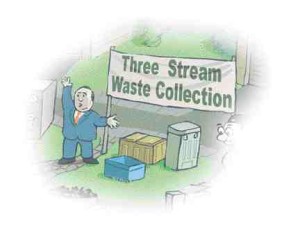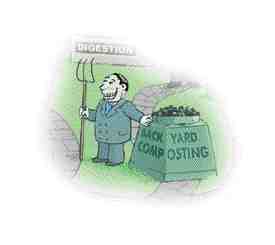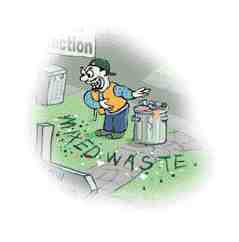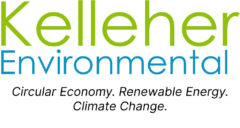New opportunities for Canadian municipalities
By: Maria Kelleher
Solid Waste Magazine – 2001-08-01
Tackling household organics is the next “quantum leap” for residential waste management systems in Canada.
Residences across Canada generate about 11-million tonnes of waste per year or about one tonne per household. About 44 per cent of this, or five million tonnes, is organic waste — food waste, leaf and yard waste and some non-recyclable paper.
Approximately one million tonnes/year of organic waste is diverted through existing programs across the country. It is clear that we need to divert a good chunk of the remaining four million organic tonnes that are currently disposed if we want to reach the 50 per cent diversion targets set by most provinces across Canada in the late 1980s. These targets were set when it was not fully understood how hard it would be to get the diversion numbers beyond about 35 per cent, which is generally reached through a combination of recycling, backyard composting and leaf and yard waste programs. The last part of the uphill struggle to 50 per cent requires comprehensive organics programs, which very few Canadian municipalities have at this time.
The benefits of organic waste diversion include conservation of landfill capacity, reduced acid generation in landfills (and metal precipitation in leachate), reduced greenhouse gas production (because methane from the decomposition of organics in anaerobic landfills is avoided), and conservation of organics that can be used as a soil conditioner.
The drawbacks of comprehensive organics diversion programs are their generally higher cost compared to the cost of disposal in most Canadian provinces, and the substantial behaviour change required of householders to source-separate the material properly.
Current compost programs
Communities that source-separate household organic waste for separate collection and processing include: Guelph, St. Thomas and Caledon in Ontario; Halifax, Lunenburg, and Bridgewater in Nova Scotia; East Prince, PEI; and, Westmorland Albert in New Brunswick.
The cities of Edmonton, Alberta and Tracy, Quebec process post-recycling residential waste to produce a compost product.
The Province of Nova Scotia has really bitten the bullet on organics. Legislation requires all landfills to be “dry landfills,” meaning organic waste must be stabilized prior to landfilling. The ban, which was introduced when old landfills in the province were being closed and waste was directed to a small number of new, highly engineered landfills — prompted communities to implement comprehensive “three-stream” waste collection.
 In the three-stream system, householders put organics in one container, recyclables in a second container, and residual garbage in the third. When the City of Halifax rolled out its three-stream system to 108,000 single-family households over the summer in 1999, it became the largest city in North America to do so. (See “Halifax’s Organic Cart System” in the June/July 1999 edition.)
In the three-stream system, householders put organics in one container, recyclables in a second container, and residual garbage in the third. When the City of Halifax rolled out its three-stream system to 108,000 single-family households over the summer in 1999, it became the largest city in North America to do so. (See “Halifax’s Organic Cart System” in the June/July 1999 edition.)
In Edmonton, Alberta a unique state-of-the-art facility was opened in May 2000. After many years of planning and negotiation, the TransAlta facility processes all residential waste from the City of Edmonton, along with biosolids from municipal wastewater treatment facilities. The resulting compost is used to rehabilitate coal strip-mines near the plant — a use that requires 10 years of compost production to complete. Finished compost is also sold to local residents.
The unique circumstances that led to the construction of this facility included a solution to two waste management operations within one facility, and the availability of a secure market for the compost quality produced by the plant. (See “The City of Edmonton Leads the Way” in the December/January 2001 edition.)
Down the highway from Edmonton, the City of Calgary is looking at options for organics management following the results of waste audits that indicated that 44 per cent of waste disposed at Calgary landfills is organic. (See special supplement article, page 21.)
 In Ontario, where leaf and yard waste and composting programs are well developed, an estimated 385,000 tonnes was diverted in 1999 (275,000 tonnes through curbside collection and 110,000 tonnes through backyard composters). Comparatively, 658,000 tonnes of waste was recovered through the recycling program. Therefore, diversion of organic waste contributes to 8.9 per cent of Ontario’s residential waste diversion.
In Ontario, where leaf and yard waste and composting programs are well developed, an estimated 385,000 tonnes was diverted in 1999 (275,000 tonnes through curbside collection and 110,000 tonnes through backyard composters). Comparatively, 658,000 tonnes of waste was recovered through the recycling program. Therefore, diversion of organic waste contributes to 8.9 per cent of Ontario’s residential waste diversion.
The City of Toronto — with over 2.2 million residents, 498,000 single-family homes and 393,000 multi-family residences — will soon be the largest community in North America to implement full curbside household organics collection. Starting with 170,000 single-family households in 2002, the city will ramp up to provide curbside collection of household organics to all single-family residences by 2005. The collected organics will be processed by anaerobic digestion plants that produce green energy. The energy can be sold to the Ontario electricity market, which opens to competition in 2002. The ambitious Task Force 2010 diversion plan was developed through intensive public consultation this spring, and will be presented to Council for full approval in September 2001.
WDO study
 The research conducted by the Ontario Waste Diversion Organization (WDO) in 2000 indicates the scope of the challenge to divert high amounts of organic waste from the residential waste stream. The WDO estimates that 2.5 million single-family households or virtually all urban single-family households in Ontario, including Northern Ontario, need to implement comprehensive curbside organics programs. In addition, waste from half of the multi-family households in the province will have to be processed in mixed waste processing facilities to recover additional organics required to meet the 50 per cent target.
The research conducted by the Ontario Waste Diversion Organization (WDO) in 2000 indicates the scope of the challenge to divert high amounts of organic waste from the residential waste stream. The WDO estimates that 2.5 million single-family households or virtually all urban single-family households in Ontario, including Northern Ontario, need to implement comprehensive curbside organics programs. In addition, waste from half of the multi-family households in the province will have to be processed in mixed waste processing facilities to recover additional organics required to meet the 50 per cent target.
The overall system costs to handle 1.1 million tonnes of organic waste are estimated at approximately $179-million per year (including amortized capital), which is an increment of $89-million more than the current system.
A more realistic but still very aggressive strategy would involve roll-out of comprehensive curbside organics collection to two million single-family households and processing of post recycling mixed waste from 275,000 multi-family households. All remaining households could divert organic waste through a combination of backyard composting and leaf and yard waste recovery. This strategy, with a price tag of $59-million, is considered feasible within a five-year time frame if the appropriate legislative and financial supports are in place. It still requires the construction of numerous processing plants and the roll out of a new collection system to most single family households in the province — a daunting challenge.
Household organics are among a list of materials that are identified in the new Waste Diversion Act of Ontario, 2001 which may be designated as materials requiring a diversion plan in the future.
Challenges and trends
The biggest challenge for any community is how to collect the household organics.
The key to economical organics processing is to get good revenue for the compost produced, so it’s essential to produce high-quality compost for which markets can be found. Composting of source-separated organics ensures that a high quality end product can be obtained, whereas compost quality is not as high when mixed waste is processed. However, the collection involved with source-separated organics is more expensive, a tricky trade off.
Other issues that need to be resolved include: the use of bags and/or bins; household container distribution; weekly/biweekly collection; the reduction of garbage collection; two-stream co-collection in one truck and collection sequence; householders separation education; and, whether leaf and yard wastes (which are seasonal) should be collected separately.
Open-windrow composting is appropriate for leaf and yard waste collection and vegetable rich food waste, but may not be suitable for full organics processing because of odour concerns. A pilot underway in Port Colborne, Ontario indicates that the open-windrow site, when properly operated, can process a full range of materials from comprehensive organics collection systems with no operating problems. Enclosed composting systems are more expensive than open windrow, but are generally chosen by communities that opt for household organics processing. The advantage of these plants is that exhaust air from the enclosed facility can be purified through biofilters, thus controlling and eliminating odour problems.
Anaerobic digestion
The interest in anaerobic digestion of residential organics is increasing across Canada and the U.S. (See article, page 21.) An advantage of anaerobic digestion is that it produces gas that can be used as a natural gas substitute. As an added benefit, this gas is considered “green energy” in electricity markets that are open to competition. To date, the costs of these plants have been higher than composting of the equivalent tonnage aerobically. However, with higher gas and energy prices, and a potential carbon trading market around the corner, the economics of these plants look more promising. While the details of carbon trading rules have not been worked yet, the carbon credits will definitely help the bottom line.
There are now more than 50 anaerobic digestion plants in Europe that process household organics. These process about one million tonnes per year of residential waste. Anaerobic digestion is a central part of the Toronto organic diversion strategy, because of the energy and greenhouse gas benefits.
Maria Kelleher is director of resource efficiency with Enviros-RIS, based in Toronto, Ontario.
The BTA-Process
Canada Composting Inc. (CCI) owns and operates a processing plant located in the Town of Newmarket just north of Toronto, Ontario. It’s the largest plant of its kind in North America and is the first of our three illustrations of “best of breed” organics diversion technologies that are up and running in Canada.
CCI uses a proprietary German technology that it owns under exclusive license in North America. The technology, known as the “BTA-Process,” provides an effective diversion solution for mixed or source-separated waste. The company claims that 66 per cent diversion is the minimum the process will achieve for a municipality. The plant is modeled closely on ten others that have been successfully established in Europe. The company also operates a similar new plant for the City of Toronto at the Dufferin Transfer Station that will be mechanically fit by October of this year. The plant will be an important module in the city’s expanded organics diversion program. (See article, page 24.)
The CCI process is illustrative of components that the new breed of organic diversion technologies has in common: Waste is digested in large vessels to produce high quality compost. As a bonus, biogas formed by microbial digestion of organic matter is converted into electrical and thermal energy. And the high-tech, odorless, computer-controlled facilities are small enough that they could fit into most commercial urban settings.
The Newmarket plant — which accepted its first load of waste in July of last year — has a design capacity of 150,000 metric tonnes of organic waste per year. This equals 450 tonnes per day. The facility occupies a very small footprint — about half of the total space of the 2.209-hectare (5.4-acre) site. CCI’s operation is currently in transition from the start-up and commissioning phase to full operation. It will eventually produce about 60,000 tonnes of compost and 5,000 kW of electricity. The power will run the plant’s internal processes and throw off enough surplus power to serve the needs of about 3,000 homes.
The process is managed from a computer control room though manual overrides are available as appropriate. Monitoring is controlled with a Foxboro computer system that uses sophisticated trendline software to compare “recipes” for compost mixtures and control the various feedstocks. The plant operates around the clock Monday to Friday with as few as three people per shift (for current 100 tonne per day volumes).
The plant is currently treating mostly IC&I waste that ranges from 65 to 70 per cent organics content, although it’s beginning to pick up municipal clients. The process also handles and incorporates fibre. Recyclable materials are recovered at the front end of the process via trommel screen and magnetic separation. The remaining material is hydropulped. (See diagram.) Heavy materials such as bones and batteries are removed from the bottom of the large containers while light materials (e.g., plastics) are raked off the top. (These small plastics will be compacted and sent off site for use as refuse-derived fuel.) The resultant organic suspension is pumped to giant hydrocyclones that spin and separate small material, grit and fines. After this, the slurry is sent via the world’s largest screw press to an enormous “methanizer” — a tower containing 750,000 “pucks” filled with microbes — where it’s anaerobically digested.
The end product requires further windrow curing and the addition of wood chips to make it suitable as a lawn product. It currently takes three days for materials to complete their journey through the plant process, then an extended period of further curing. In future, materials will pass through the process twice — this will reduce the curing period to only a few days. In addition, methane gas from the methanizer tower runs cogeneration turbines and, in future, nutrient-rich process water will be sold to farmers. Interestingly, tests show that the wastewater discharged from the plant is cleaner than the discharge from the Ashbridges Bay treatment plant where it is currently sent. Process air passes through a biofilter before atmospheric discharge.
Anaerobic Digestion System
SUBBOR stands for “Super Blue Box Recycling Corp.” — an affiliate of Eastern Power Limited, a medium-size private company that has been in the alternative power business for 15 years. The company has won numerous environmental awards and operates the 2nd and 3rd largest landfill biogas power plants in the world, one of which operates at the Keele Valley Landfill northwest of Toronto, Ontario. President Greg Vogt leads the company and, not surprisingly, the SUBBOR process also derives energy efficiently from its anaerobic organics composting process.
The SUBBOR technology is currently in operation at the City of Guelph where it processes mixed, unsorted MSW and will provide greater than 50 per cent diversion. The developers of the technology believe the system will enable Ontario to surpass an 80 per cent diversion goal at costs competitive with landfill disposal. According to Mr. Vogt the Canadian federal government has provided $6.8-million to assist the Ontario-developed technology and the Municipal Issues and Technology Tables of the Climate Change Secretariat — call for 70 per cent diversion. Both have identified SUBBOR technology for this purpose. Methane is 21 times more potent than carbon dioxide, the primary greenhouse gas. In fact, relative to landfilling and other options, the process provides greenhouse gas reduction and energy offset credits of up to 2.8 tonnes of equivalent CO2 per tonne of processed waste. (See Editorial, page 4.)
The over $25-million demonstration facility at Guelph, Ontario, was built in partnership with Industry Canada. The large building that houses SUBBOR’s impressive technology array is attached to the back end of the Guelph Wet/Dry plant. A certain percentage of waste is sent to the SUBBOR facility for processing in order to demonstrate the technology and this volume is expected to increase. SUBBOR representative Matt Larmour says that the Guelph plant is capable of processing 100,000 tonnes of garbage a year through the mostly mechanized system.
The first stage of the process is conventional recycling and involves the use of automated, mechanical equipment to recover between 25 and 30 per cent of the incoming waste. Materials recovered include aluminum cans, plastics, ferrous metals, and paper. Unsorted garbage is dumped into a machine that rips open bags and shreds the material. Conveyer belts take the material away and magnets and eddy currents remove ferrous and aluminum.
At the second stage the innovative aspect of the SUBBOR process kicks in. The waste, by now mostly organic, is subjected to multi-stage anaerobic digestion in three large enclosed tanks. During digestion most of the waste is converted to methane-rich biogas that is used in a power plant. The digesters are kept slightly warmer than similar systems (such as those in Europe). At about 55°C the growth of different families of anaerobic bacteria is encouraged. The modifications increase the amount of usable gas drawn from the organic material and improve the quality of the final material. Over a period of 40 days, bacteria metabolize fibre and food scraps and convert them into a concoction of smaller molecules.
After the methane and carbon dioxide have been siphoned off, the material is put through a fine screen that filters out the glass and plastic for recycling. The material goes through a final process to remove the heavy metals. For every 100 kilograms of garbage processed, 50 kg of biogas, 30 kg of glass and metals, and 20 kg of peat are produced. This cured high-grade final product is not really like the dark moist material of conventional composting processes. Instead, it’s an odorless and grayish fluffy material very similar to the sought-after peat that’s used as a soil amendment for agricultural or horticultural applications.
